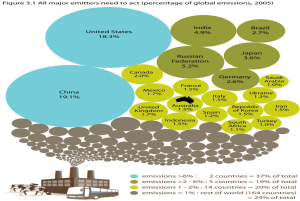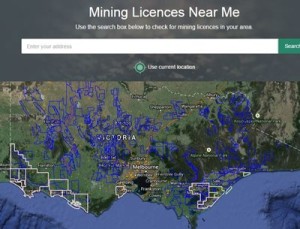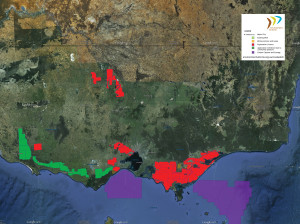What you will find on this page: LATEST NEWS; Fossil fuel emissions have stalled; does the world need hydrogen?; Mapped: global coal trade; Complexity of energy systems (maps); Mapped: Germany’s energy sources (interactive access); Power to the people (video); Unburnable Carbon (report); Stern Commission Review; Garnaut reports; live generation data; fossil fuel subsidies; divestment; how to run a divestment campaign guide; local council divestment guide; US coal plant retirement; oil conventional & unconventional; CSG battle in Australia (videos); CSG battle in Victoria; leasing maps for Victoria; coal projects Victoria
Huge task to decarbonise
Source: Australian Delegation presentation to international forum held in Bonn in May 2012
Latest News 23 July 2015, The Conversation, Native forests can help hit emissions targets – if we leave them alone: The debate over native forest logging has been sparked once again, partly by the government’s successful push for wood burning to be included in the revamped Renewable Energy Target. However, the disagreement over the best way to manage Australia’s 9.4 million hectares of public native forest is thrown into sharp relief by analysis showing that ending native forest logging, and completing the the industry’s shift into plantations instead, would get Australia much of the way to its greenhouse gas emissions reductions target. Analysis done using the Australian government’s public native forest model suggests that stopping all harvesting in the public native forest estate would generate in the order of 38 million tonnes of potential credits (that is, the equivalent of 38 million tonnes of carbon dioxide emissions avoided) each year in the short to medium term. While this is the technical capacity, the Kyoto Protocol’s rules cap credits from forest management at 3.5% of base-year emissions, or around 15 million tonnes of CO2 equivalent per year. So if Australia ratifies the second commitment period of the Protocol, which runs from 2013 to 2020, the cap would limit forest management credits to 120 million tonnes of CO2 equivalent over the commitment period. The Australian government’s latest emissions projections estimate that, in order to meet its 5% emissions-reduction target in 2020, Australia has to reduce its emissions by 236 million tonnes of CO2 equivalent over the second commitment period. This means stopping harvesting in public native forests could provide 51% of the abatement task to 2020. Read More here 22 July 2015, The Guardian, Victorian farmers and green groups firm on CSG fracking ban as inquiry fires up. As parliamentary inquiry into ramifications of drilling gets under way, farmers fear state’s moratorium on coal seam gas may be lifted. Farmers and environmental groups have lined up against the oil and gas industry to oppose fracking of unconventional gas in Victoria, as a parliamentary inquiry into its potential benefits gets under way. A parliamentary committee began hearings in Melbourne on Wednesday morning into the economic, social and environmental ramifications of allowing Victoria to be opened up for gas drilling. Victoria has banned unconventional gas exploration, which includes coal seam gas and tight gas, since 2012. Since then, the expansion of coal seam gas in New South Wales and Queensland has sparked fierce protests from green groups and some local residents. In January, Victoria’s Labor government extended the ban until the committee handed down its findings. A review conducted by the former Coalition government recommended that regulations around fracking for gas be relaxed. Advocates for gas drilling claim Victoria would benefit financially and households would enjoy lower gas prices if supply were increased. Read More here 21 July 2015, The Conversation, One year on from the carbon price experiment, the rebound in emissions is clear: Just over a year ago, Australia concluded a unique public policy experiment. For the preceding two years and two weeks, it had put a price on a range of greenhouse gas emitting activities, most significantly power generation. Now, 12 months since the price was removed, is a good time to assess the results of the experiment. The immediate effect of the carbon price was to increase the costs faced by most electricity generators, by an amount that varied between individual power stations depending on that station’s emissions intensity (the emissions per unit of electricity). These costs were then passed on in higher prices to consumers. Simple economics suggests that two effects should have followed. First, less emissions-intensive generators should have been able to increase their market share, resulting in an overall reduction in the average emissions intensity of electricity. Second, higher prices should have led consumers to reduce their consumption, cutting the total demand for electricity. When the price was removed, both of these effects should have been reversed. Let’s look at what happened in the National Electricity Market (NEM), which is the wholesale electricity market in every state and territory except Western Australia and the Northern Territory. My analysis, using detailed NEM operational data from the Australian Energy Market Operator (AEMO) finds that emissions intensity, which was increasing until shortly before June 2012, fell continuously (see graph below) for most of the two years to June 2014. Since then, it has increased consistently. All these changes were caused by changes in the market shares the different types of generation, just as expected. Read More here 18 July 2015, The Conversation, Australia’s ‘Carnival of Coal’ – can you feel the love? As the latest State of the Climate report reaffirms 2014 to be “the hottest on record”, the NSW Liberal Party is pressing ahead with plans for a “Carnival of Coal” in August. The party’s upper house whip, Peter Phelps, has appealed to members to download a sticker for MP office doors in support of the upcoming carbon love-in. It says: I loved carbon before it was coal. The Liberal paleo-love for coal, which Tony Abbott has declared “good for humanity”, is at least a point of differentiation with Labor. Labor does not promote such slogans at all – even if, in Victoria, the Andrews Labor government is still issuing coal exploration licences. Both parties are capable of romancing the coal industry. But Liberal parties around the country have had much more success in convincing voters that either coal is more important than climate, or have decided that – with a population drip-fed on attention-deficit-consumerism and its reality television advertorials – their connection can be comfortably sublimated. Whatever its form, the love for coal in Australia is going to end badly, like all relationships based on fantasy. To slightly misquote a 19th-century philosopher: the demand to give up the illusion that coal is good for humanity is the demand to give up a condition which needs such an illusion. Read More here 29 April 2018, The Guardian, Budget earmarks $500m to mitigate Great Barrier Reef climate change. The Turnbull government will allocate $500m to mitigate the impacts of climate change on the Great Barrier Reef. The funding, to be unveiled on Sunday and confirmed in the May budget, follows a recent study finding that 30% of the reef’s corals died in a catastrophic nine-month marine heatwave in 2016. The government will partner with the Great Barrier Reef Foundation in a $444m agreement to tackle crown-of-thorns starfish, reduce pollution and mitigate the impacts of climate change. The government will increase funding for the Great Barrier Reef Marine Park Authority and the Department of the Environment and Energy by $56m to expand environmental management and compliance operations. Both of the major parties are currently focused on winning hearts and minds in Queensland, with the state’s marginal seats likely to determine the outcome of the next federal election. The Coalition has been criticised by environment groups for not acting fast enough to protect the reef, and the government’s support for the Adani coalmine has also been controversial both locally and nationally because of its potential impact on the reef.In January Guardian Australia revealed that millions of dollars of commonwealth money was being handed to tourism-linked groups for reef protection, despite official advice recommending against the projects, or repeatedly finding them to be failing. Read more here 25 April 2018, Bloomberg, The Fighting Has Begun Over Who Owns Land Drowned by Climate Change. One April morning in 2016, Daryl Carpenter, a charter boat captain out of Grand Isle, La., took some clients to catch redfish on a marsh pond that didn’t use to exist. Coastal erosion and rising seas are submerging a football field’s worth of Louisiana land every hour, creating and expanding ponds and lakes such as the one onto which Carpenter had piloted his 24-foot vessel. Suddenly, another boat pulled up beside Carpenter’s. “You’re trespassing,” the other driver declared, before chasing him and his clients down the bayou. The sheriff’s office later threatened to arrest Carpenter if he ever returned to the pond. There was just one problem: Under Louisiana state law, any waterways that are accessible by boat are supposed to be public property, argued Carpenter—even what was previously unnavigable swampland. Carpenter sued the sheriff, as well as Castex Energy Inc., which owns the property around the pond, for interfering with his business. A district court decided against him in March, noting that an earlier ruling found that the territory was unnavigable swampland when the state sold it into private ownership in the 1800s. Carpenter is appealing that ruling. Carpenter’s suit reflects a legal and political dilemma that’s beginning to reverberate around the country: As seas rise and coasts wash away, who owns the land that goes underwater? Read more here 20 April 2018, The Conversation, Federal government sets sights on August approval for National Energy Guarantee. Federal energy minister Josh Frydenberg says he is confident of securing state governments’ support for the National Energy Guarantee, with a final decision now timetabled for August. At a meeting today, state energy ministers agreed to progress towards a final version of the policy, which aims to ensure a reliable electricity supply while also cutting the sector’s greenhouse emissions by 26% by 2030. Details of the policy were first unveiled in October 2017, after the federal government opted against Chief Scientist Alan Finkel’s recommended Clean Energy Target. It features two components: a “reliability guarantee” and an “emissions guarantee”. Under the latest iteration of the policy, developed by the Energy Security Board, electricity retailers would be required to ensure they do not exceed a certain level of greenhouse emissions per unit of electricity sold. They would also be expected to invest in extra generation capacity in advance of any forecast shortfall, so as to ensure reliability. Grattan Institute energy analyst David Blowers wrote this week that although the 26% emissions target is far too modest, the policy could deliver much-needed bipartisan political support. It would create investment certainty and then could be ramped up later. But RMIT’s Alan Pears previously wrote that the government’s slow and modest policy ambition has been overtaken by the breakneck pace of change in renewables and energy efficiency. Economic analysts have voiced fears that the policy’s “technology-neutral” approach is a stalking-horse for coal and may put the brakes on renewable energy investment in Australia. Read more here 18 April 2018, Environmental Justice Australia. CCS: Throwing good money after bad pollution.Given the known failures of carbon capture and storage – and given that the federal government has lost millions of taxpayers’ dollars to CCS already – investing in such technologies could amount to improper use of public funds, writes EJA’s Bronya Lipski. In 2009 the Rudd government initiated a $1 billion carbon capture and storage program that was supposed to deliver two to four large-scale CCS projects. The program was significantly scaled back by the Abbott government in 2014. This downsizing was consistent with global trends, as it became increasingly apparent to governments that CCS was not an economically, nor an environmentally, appropriate pathway to serious emissions reductions. In 2017 the Australian National Audit Office reviewed the Federal Government’s CCS program and found none of the projects met the original timeframe or reached the stage of deployable technology, as originally envisaged in the program design. It seems bizarre, then, after the Abbott government stripped the CCS program of funds, and after the ANAO report found the project was overwhelmingly unsuccessful, that the Federal Government would now float the idea that the Clean Energy Finance Corporation (CEFC) should be allowed to invest in CCS. That is what is proposed in the Clean Energy Finance Corporation Amendment (Carbon Capture and Storage) Bill. When the CEFC was first introduced in 2012, Mathias Cormann (then in Opposition) said the Rudd Government was ‘throwing money at ventures that are not commercially viable and that are competing with those projects that are trying to make a success of things’. In fact, the CEFC has been a great success – financially and for clean energy. Around this time last year, the CEFC said it had invested more than $3.3 billion in eligible clean energy projects, with a total project value of $8.3 billion, while also delivering a positive return for the taxpayer. Strong evidence suggests investing in CCS projects would not provide positive returns like investing in clean energy does. Read more here 3 November 2020, Carbon Brief: Hydrogen gas has long been recognised as an alternative to fossil fuels and a potentially valuable tool for tackling climate change. Now, as nations come forward with net-zero strategies to align with their international climate targets, hydrogen has once again risen up the agenda from Australia and the UK through to Germany and Japan. In the most optimistic outlooks, hydrogen could soon power trucks, planes and ships. It could heat homes, balance electricity grids and help heavy industry to make everything from steel to cement. But doing all these things with hydrogen would require staggering quantities of the fuel, which is only as clean as the methods used to produce it. Moreover, for every potentially transformative application of hydrogen, there are unique challenges that must be overcome. In this in-depth Q&A – which includes a range of infographics, maps and interactive charts, as well as the views of dozens of experts – Carbon Brief examines the big questions around the “hydrogen economy” and looks at the extent to which it could help the world avoid dangerous climate change. Access full article here Fossil fuel emissions have stalled 14 November 2016, The Conversation, Fossil fuel emissions have stalled: Global Carbon Budget 2016. For the third year in a row, global carbon dioxide emissions from fossil fuels and industry have barely grown, while the global economy has continued to grow strongly. This level of decoupling of carbon emissions from global economic growth is unprecedented.Global CO₂ emissions from the combustion of fossil fuels and industry (including cement production) were 36.3 billion tonnes in 2015, the same as in 2014, and are projected to rise by only 0.2% in 2016 to reach 36.4 billion tonnes. This is a remarkable departure from emissions growth rates of 2.3% for the previous decade, and more than 3% during the 2000’s. Read More here Do you want to understand the complexity of energy systems which support our high consumption lifestyles? Most people don’t give too much thought to where their electricity comes from. Flip a switch, and the lights go on. That’s all. The origins of that energy, or how it actually got into our homes, is generally hidden from view. This link will take you to 11 maps which explain energy in America (it is typical enough as an example of a similar lifestyle as Australia – when I find maps for Oz I’ll add them in) e.g. above map showing the coal plants in the US. Source: Vox Explainers Mapped: how Germany generates its electricity – another example Power to the People – Lock the Gate looks back at the wins of 2015 And there’s lots more coming up in 2016. Some of the big priorities coming up next for the “Lock the Gate” movement are: If you want to give “Lock the Gate” your support – go here for more info This new report reveals that the pollution from Australia’s coal resources, particularly the enormous Galilee coal basin, could take us two-thirds of the way to a two degree rise in global temperature. To Read More and download report The 2006 UK government commissioned Stern Commission Review on the Economics of Climate Change is still the best complete appraisal of global climate change economics. The review broke new ground on climate change assessment in a number of ways. It made headlines by concluding that avoiding global climate change catastrophe was almost beyond our grasp. It also found that the costs of ignoring global climate change could be as great as the Great Depression and the two World Wars combined. The review was (still is) in fact a very good assessment of global climate change, which inferred in 2006 that the situation was a global emergency. Read More here The Garnaut Climate Change Review was commissioned by the Commonwealth, state and territory governments in 2007 to conduct an independent study of the impacts of climate change on the Australian economy. Prof. Garnaut presented The Garnaut Climate Change Review: Final Report to the Australian Prime Minister, Premiers and Chief Ministers in September 2008 in which he examined how Australia was likely to be affected by climate change, and suggested policy responses. In November 2010, he was commissioned by the Australian Government to provide an update to the 2008 Review. In particular, he was asked to examine whether significant changes had occurred that would affect the analysis and recommendations from 2008. The final report was presented May 2011. Since then the Professor has regularly participated in the debate of fossil fuel reduction, as per his latest below: To access his reports; interviews; submissions go here 27 May 2015, Renew Economy, Garnaut: Cost of stranded assets already bigger than cost of climate action. This is one carbon budget that Australia has already blown. Economist and climate change advisor Professor Ross Garnaut has delivered a withering critique of Australia’s economic policies and investment patterns, saying the cost of misguided over-investment in the recent mining boom would likely outweigh the cost of climate action over the next few decades. Read More here Live generation of electricity by fuel type Fossil Fuel Subsidies – The Age of entitlement continues 24 June 2014, Renew Economy, Age of entitlement has not ended for fossil fuels: A new report from The Australia Institute exposes the massive scale of state government assistance, totalling $17.6 billion over a six-year period, not including significant Federal government support and subsidies. Queensland taxpayers are providing the greatest assistance by far with a total of $9.5 billion, followed by Western Australia at $6.2 billion. The table shows almost $18 billion dollars has been spent over the past 6 years by state governments, supporting some of Australia’s biggest, most profitable industries, which are sending most of the profits offshore. That’s $18 billion dollars that could have gone to vital public services such as hospitals, schools and emergency services. State governments are usually associated with the provision of essential services like health and education so it will shock taxpayers to learn of the massive scale of government handouts to the minerals and fossil fuel industries. This report shows that Australian taxpayers have been misled about the costs and benefits of this industry, which we can now see are grossly disproportionate. Each state provides millions of dollars’ worth of assistance to the mining industry every year, with the big mining states of Queensland and Western Australia routinely spending over one billion dollars in assistance annually. Read More here – access full report here What is fossil fuel divestment? Local Governments ready to divest Aligning Council Money With Council Values A Guide To Ensuring Council Money Isn’t Funding Climate Change. 350.org Australia – with the help of the incredible team at Earth Hour – has pulled together a simple 3-step guide for local governments interested in divestment. The movement to align council money with council values is constantly growing in Australia. It complements the existing work that councils are doing to shape a safe climate future. It can also help to reshape the funding practices of Australia’s fossil fuel funding banks. The steps are simple. The impact is huge.The guide can also be used by local groups who are interested in supporting their local government to divest as a step-by-step reference point. Access guide here How coal is staying in the ground in the US Sierra Club Beyond Coal Campaign May 2015, Politico, Michael Grunwald: The war on coal is not just political rhetoric, or a paranoid fantasy concocted by rapacious polluters. It’s real and it’s relentless. Over the past five years, it has killed a coal-fired power plant every 10 days. It has quietly transformed the U.S. electric grid and the global climate debate. The industry and its supporters use “war on coal” as shorthand for a ferocious assault by a hostile White House, but the real war on coal is not primarily an Obama war, or even a Washington war. It’s a guerrilla war. The front lines are not at the Environmental Protection Agency or the Supreme Court. If you want to see how the fossil fuel that once powered most of the country is being battered by enemy forces, you have to watch state and local hearings where utility commissions and other obscure governing bodies debate individual coal plants. You probably won’t find much drama. You’ll definitely find lawyers from the Sierra Club’s Beyond Coal campaign, the boots on the ground in the war on coal. Read More here Oil – conventional & unconventional May 2015, Oil change International Report: On the Edge: 1.6 Million Barrels per Day of Proposed Tar Sands Oil on Life Support. The Canadian tar sands is among the most carbon-intensive, highest-cost sources of oil in the world. Even prior to the precipitous drop in global oil prices late last year, three major projects were cancelled in the sector with companies unable to chart a profitable path forward. Since the collapse in global oil prices, the sector has been under pressure to make further cuts, leading to substantial budget cuts, job losses, and a much more bearish outlook on expansion projections in the coming years. Read full report here. For summary of report USA Sierra Club Beyond Oil Campaign Coal Seam Gas battle in Australia Lock the Gate Alliance is a national coalition of people from across Australia, including farmers, traditional custodians, conservationists and urban residents, who are uniting to protect our common heritage – our land, water and communities – from unsafe or inappropriate mining for coal seam gas and other fossil fuels. Read more about the missions and principles of Lock the Gate. Access more Lock the Gate videos here. Access Lock the Gate fact sheets here 2014: Parliament of Victoria Research Paper: Unconventional Gas: Coal Seam Gas, Shale Gas and Tight Gas: This Research Paper provides an introduction and overview of issues relevant to the development of unconventional gas – coal seam, shale and tight gas – in the Australian and specifically Victorian context. At present, the Victorian unconventional gas industry is at a very early stage. It is not yet known whether there is any coal seam gas or shale gas in Victoria and, if there is, whether it would be economically viable to extract it. A moratorium on fracking has been in place in Victoria since August 2012 while more information is gathered on potential environmental risks posed by the industry. The parts of Victoria with the highest potential for unconventional gas are the Gippsland and Otway basins. Notably, tight gas has been located near Seaspray in Gippsland but is not yet being produced. There is a high level of community concern in regard to the potential impact an unconventional gas industry could have on agriculture in the Gippsland and Otway regions. Industry proponents, however, assert that conventional gas resources are declining and Victoria’s unconventional gas resources need to be ascertained and developed. Read More here 28 January 2015, ABC News, Coal seam gas exploration: Victoria’s fracking ban to remain as Parliament probes regulations: A ban on coal seam gas (CSG) exploration will stay in place in Victoria until a parliamentary inquiry hands down its findings, the State Government has promised. There is a moratorium on the controversial mining technique, known as fracking, until the middle of 2015. The Napthine government conducted a review into CSG, headed by former Howard government minister Peter Reith, which recommended regulations around fracking be relaxed. Labor was critical of the review, claiming it failed to consult with farmers, environmental scientists and local communities. Read more here Keep up to date and how you can be involved here Friends of the Earth Melbourne Coal & Gas Free Victoria 20 May 2015, FoE, Inquiry into Unconventional Gas: Check here for details on the Victorian government’s Inquiry into unconventional gas. The public hearings have not yet started, however the Terms of Reference have been released. The state government’s promised Inquiry into Unconventional Gas has now been formally announced, with broad terms of reference (TOR). FoE’s response to the TOR is available here. The Upper House Environment and Planning Committee will manage the Inquiry. You can find the Inquiry website here. The final TOR will be determined by the committee. Significantly, it is a cross party committee. The Chair is a Liberal (David Davis), and there is one National (Melinda Bath), one Green (Samantha Dunn), three from the ALP (Gayle Tierney, Harriet Shing, Shaun Leane), an additional MP from the Liberals (Richard Dalla-Riva), and one MP from the Shooters Party (Daniel Young). Work started by the previous government, into water tables and the community consultation process run by the Primary Agency, will be released as part of the inquiry.The moratorium on unconventional gas exploration will stay in place until the inquiry delivers its findings. The interim report is due in September and the final report by December. There is the possibility that the committee will amend this timeline if they are overwhelmed with submissions or information. Parliament will then need to consider the recommendations of the committee and make a final decision about how to proceed. This is likely to happen when parliament resumes after the summer break, in early 2016. Quit Coal is a Melbourne-based collective that campaigns against the expansion of the coal and unconventional gas industries in Victoria. Quit Coal uses a range of tactics to tackle this problem. We advise the broader Victorian community about plans for new coal and unconventional gas projects, we put pressure on our government to stop investing in these projects, and we help to inform and mobilise Victorian communities so they can campaign on their own behalf. We focus on being strategic, creative, and as much as possible, fun! The above screen shot is of the Victorian State government’s Mining Licences Near Me site. Go to this link to see what is happening in your area Environment Victoria’s campaign CoalWatch is an interactive resource that tracks the coal industry’s expansion plans and helps builds a movement to stop these polluting developments. CoalWatch provides a way for everyday Victorians to keep track of the coal industry’s ambitious expansion plans. To check what tax-payer money has been pledged to brown coal projects and the coal projects industry is spruiking to our politicians. Here’s another map via EV website (go to their website and you should be able to get better detail from Google Maps: Red areas: Exploration licences (EL). These areas are held by companies to undertake exploration activity. A small bond is held by government in case of any damage. If a company wants to progress the project it needs to obtain a mining licence. Exploration Licence applications are marked with an asterix in the Places Index eg. EL4684*. Yellow areas: Mining Licences (MIN). A mining licence is granted with the expectation that mining will occur. A larger bond is paid to government. Green areas: Exploration licences that have been withdrawn or altered due to community concern. Green outline: Existing mines within Mining Licences. Purple areas: Geological Carbon Storage Exploration areas for carbon capture and storage. On-shore areas have been released by the State Government, while off-shore areas have been released by the Federal Government. The Coal Watch wiki tracks current and future Victorian coal projects, whether they are power stations, coal mines, proposals to export coal or some other inventive way of burning more coal. To get the full picture of coal in Victoria visit our wiki page. Get more info and see the full list of Exploration Licences current at 17 August 2012 here August 2015, Institute for Energy Economics & Financial Analysis – powerpoint: Changing Dynamics in the Global Seaborne Thermal Coal Markets and Stranded Asset Risk. Information from one of the slides follows. To view full presentation go here Economic Implications for Australia 83% of Australian coal mines are foreign owned, hence direct leverage of fossil fuels to the ASX is relatively small at 1-2%. However, for Australia the exposure is high, time is needed for transition and the new industry opportunities are significant: 1. Energy Infrastructure: Australia spends $5-10bn pa on electricity / grid sector, much of it a regulated asset base that all ratepayers fund much of it stranded. BNEF estimate of Australia’s renewable energy infrastructure investment for 2015-2020 was cut 30% from A$20bn post RET. Lost opportunities. 2. Direct employment: The ABS shows a fall of ~20k from the 2012 peak of 70K from coal mining across Australia, and cuts are ongoing. Indirect employment material. 3. Terms of trade: BZE estimates the collapse in the pricing of iron ore, coal and LNG cuts A$100bn pa from Australia’s export revenues by 2030, a halving relative to government budget estimates of 2013/14. Coal was 25% of NSW’s total A$ value of exports in 2013/14 (38% of Qld). Australia will be #1 globally in LNG by 2018. 4. The financial sector: is leveraged to mining and associated rail port infrastructure. WICET 80% financed by banks, mostly Australian. Adani’s Abbot Point Port is foreign owned, but A$1.2bn of Australian sourced debt. Insurance firms and infrastructure funds are leveraged to fossil fuels vs little RE infrastructure assets. BBY! 5. Rehabilitation: $18bn of unfunded coal mining rehabilitation across Australia. 6. Economic growth: curtailed as Australia fails to develop low carbon industries. In-depth Q&A: Does the world need hydrogen to solve climate change?
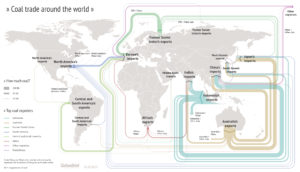 3 May 2016, Carbon Brief, The global coal trade doubled in the decade to 2012 as a coal-fueled boom took hold in Asia. Now, the coal trade seems to have stalled, or even gone into reverse. This change of fortune has devastated the coal mining industry, with Peabody – the world’s largest private coal-mining company – the latest of 50 US firms to file for bankruptcy. It could also be a turning point for the climate, with the continued burning of coal the biggest difference between business-as-usual emissions and avoiding dangerous climate change. Carbon Brief has produced a series of maps and interactive charts to show how the global coal trade is changing. As well as providing a global overview, we focus on a few key countries: Read More here
3 May 2016, Carbon Brief, The global coal trade doubled in the decade to 2012 as a coal-fueled boom took hold in Asia. Now, the coal trade seems to have stalled, or even gone into reverse. This change of fortune has devastated the coal mining industry, with Peabody – the world’s largest private coal-mining company – the latest of 50 US firms to file for bankruptcy. It could also be a turning point for the climate, with the continued burning of coal the biggest difference between business-as-usual emissions and avoiding dangerous climate change. Carbon Brief has produced a series of maps and interactive charts to show how the global coal trade is changing. As well as providing a global overview, we focus on a few key countries: Read More here/cdn0.vox-cdn.com/uploads/chorus_asset/file/3915730/EIA%20coal%20power%20plants.png)
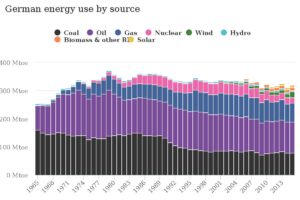
21 April 2015, Climate Council, Will Steffen: Unburnable Carbon: Why we need to leave fossil fuels in the ground.Stern Commission Review
Australia’s Garnaut Review
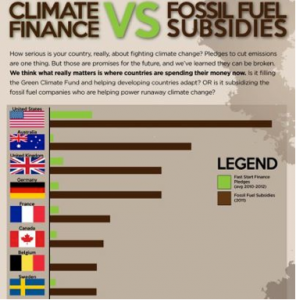 November 2014 – The Fossil Fuel Bailout: G20 subsidies for oil, gas and coal exploration report: Governments across the G20 countries are estimated to be spending $88 billion every year subsidising exploration for fossil fuels. Their exploration subsidies marry bad economics with potentially disastrous consequences for climate change. In effect, governments are propping up the development of oil, gas and coal reserves that cannot be exploited if the world is to avoid dangerous climate change. This report documents, for the first time, the scale and structure of fossil fuel exploration subsidies in the G20 countries. The evidence points to a publicly financed bailout for carbon-intensive companies, and support for uneconomic investments that could drive the planet far beyond the internationally agreed target of limiting global temperature increases to no more than 2ºC. It finds that, by providing subsidies for fossil fuel exploration, the G20 countries are creating a ‘triple-lose’ scenario. They are directing large volumes of finance into high-carbon assets that cannot be exploited without catastrophic climate effects. They are diverting investment from economic low-carbon alternatives such as solar, wind and hydro-power. And they are undermining the prospects for an ambitious climate deal in 2015. Access full report here For the summary on Australia’s susidisation of it’s fossil fuel industry go to page 51 of the report. The report said that the United States and Australia paid the highest level of national subsidies for exploration in the form of direct spending or tax breaks. Overall, G20 country spending on national subsidies was $23 billion. In Australia, this includes exploration funding for Geoscience Australia and tax deductions for mining and petroleum exploration. The report also classifies the Federal Government’s fuel rebate program for resources companies as a subsidy.
November 2014 – The Fossil Fuel Bailout: G20 subsidies for oil, gas and coal exploration report: Governments across the G20 countries are estimated to be spending $88 billion every year subsidising exploration for fossil fuels. Their exploration subsidies marry bad economics with potentially disastrous consequences for climate change. In effect, governments are propping up the development of oil, gas and coal reserves that cannot be exploited if the world is to avoid dangerous climate change. This report documents, for the first time, the scale and structure of fossil fuel exploration subsidies in the G20 countries. The evidence points to a publicly financed bailout for carbon-intensive companies, and support for uneconomic investments that could drive the planet far beyond the internationally agreed target of limiting global temperature increases to no more than 2ºC. It finds that, by providing subsidies for fossil fuel exploration, the G20 countries are creating a ‘triple-lose’ scenario. They are directing large volumes of finance into high-carbon assets that cannot be exploited without catastrophic climate effects. They are diverting investment from economic low-carbon alternatives such as solar, wind and hydro-power. And they are undermining the prospects for an ambitious climate deal in 2015. Access full report here For the summary on Australia’s susidisation of it’s fossil fuel industry go to page 51 of the report. The report said that the United States and Australia paid the highest level of national subsidies for exploration in the form of direct spending or tax breaks. Overall, G20 country spending on national subsidies was $23 billion. In Australia, this includes exploration funding for Geoscience Australia and tax deductions for mining and petroleum exploration. The report also classifies the Federal Government’s fuel rebate program for resources companies as a subsidy.

